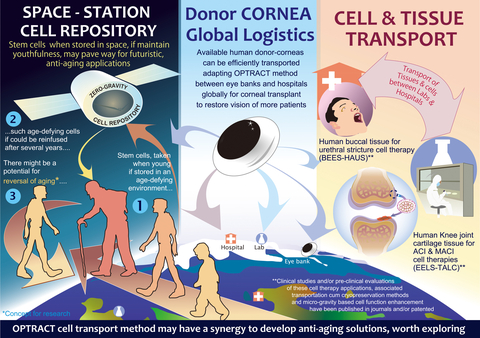Cell therapies in regenerative medicine involve tissue harvesting in hospitals, transporting to cell processing facilities, isolating, culturing cells, and preserving for varying durations until transplantation to patients.
Scientists with Inter-disciplinary expertise have accomplished the following path-breaking solutions, using chemically concocted polymer scaffolds:
- Human cadaver donor corneal transport with better preservation of corneal endothelial density: https://doi.org/10.1007/s10529-021-03116-y
- Preservation and transportation of human buccal mucosa for male urethral stricture treatment: https://doi.org/10.1089/bio.2021.0079
- Cartilage transport for ACI & MACI cell therapies, to treat knee joint damage: https://doi.org/10.1016/j.jor.2022.01.007
- Corneal endothelial logistics without cold chain (https://pubmed.ncbi.nlm.nih.gov/24008800/) and treatment of bullous keratopathy: https://www.ncbi.nlm.nih.gov/pmc/articles/PMC5840311/
- Microgravity, enhancing nitric oxide, a weapon of immune cells to destroy cancer: Japan patent: 6757578/2020
- Cryopreservation of bone marrow and cord blood stem cells: Japan patent: 6373241/2018
Having proven phenotype maintenance and better viability of human cells and tissues under varying temperatures outside the body, enhancement of natural killer cells and reversal of cellular senescence in the lab (https://doi.org/10.1038/s41598-021-93607-9), they envision studying cell biology and epigenetics in the zero-gravity environment of a space station, to which cells could be transported and stored, if proven mitigating senescence, that may yield cues to anti-aging solutions, they propose.
“Time has come for a dream project of cell-repository aboard a space-station, with like-minded institutes, which may herald the birth of a novel, space-age anti-aging medicine”, comments Dr. Shojiro Katoh, President, Edogawa Hospital, with beaming hope, as his collaborators appreciated a wholesome ecosystem in Japan, enabling development of novel solutions, its synergy with inter-disciplinary expertise and global network of GN Corp and support from JBM Inc.
https://sponsored.bloomberg.com/article/jco/japan-where-high-tech-meets-high-value-foreign-direct-investment





